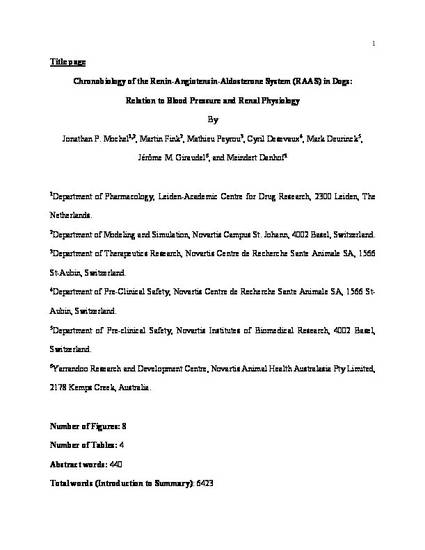
Article
Chronobiology of the renin-angiotensin-aldosterone system in dogs: relation to blood pressure and renal physiology
Chronobiology International
(2013)
Abstract
The renin-angiotensin-aldosterone system (RAAS) plays a pivotal role in the regulation of blood
pressure and volume homeostasis. Its contribution to the development of cardiovascular diseases
has long been recognized. Extensive literature has shown that peptides of the RAAS oscillate
with a circadian periodicity in humans, under strong influence of posture, sleep and age.
Although observations of time-variant changes in the renin cascade are available in dogs, no
detailed chronobiological investigation has been conducted so far. The present studies were
designed to explore the circadian variations of plasma renin activity (RA) and urinary
aldosterone to creatinine ratio (UA:C) in relation to blood pressure (BP), sodium (UNa, UNa,fe), and
potassium (UK, UK,fe) renal handling.
Data derived from intensive blood and urine sampling, as well as continuous BP monitoring
were collected throughout a 24-hour time period, and analyzed by means of nonlinear mixedeffects
models. Differences between the geometric means of day and night observations were
compared by parametric statistics.
Our results show that variables of the renin cascade, BP and urinary electrolytes oscillate with
significant day-night differences in dogs. An approximately 2-fold (1.6-3.2-fold) change between
the average day and night measurements was found for RA (p<.001), UA:C (p: .01), UK,fe (p: .01),
and UNa (p: .007). Circadian variations in BP, albeit small (less than 10 mmHg), were
statistically significant (p<.01) and supported by the model-based analysis. For all variables but
UNa and UNa,fe the levels were higher at night than during the day. The data also indicate that
blood pressure oscillates in parallel to the RAAS, such that, as opposed to healthy humans BP
does not drop at night in dogs.
The postprandial decrease in RA is assumed to be related to body fluid volume expansion
secondary to water and sodium intake, while the reduction of UA:C reflects aldosterone-stimulated
secretion by the renin-angiotensin II pathway. UNa and UNa,fe peaked in the afternoon, about 7-8
hours after food intake, which is consistent with the “impulse-response pattern” of sodium
excretion described in previous publications. Finally, UK and UK,fe mirrored aldosteronemediated
potassium secretion in the kidney tubules.
To describe the circadian variations of the various variables two different mathematical
representations were applied. A cosine model with a fixed 24-hour period was found to fit the
periodic variations of RA, UA:C, UK, UK,fe, and BP well, while changes in UNa and UNa,fe were
best characterized by a surge model. The use of nonlinear mixed-effects allowed to estimate
population characteristics that can influence the periodicity of the RAAS. Specifically, sodium
intake was found to interact with the tonic and the phasic secretion of renin, suggesting that
varying feeding time could also impact the chronobiology of the renin cascade.
Keywords
- Circadian periodicity,
- Nonlinear mixed-effects modeling,
- Covariate,
- Chronotherapy
Disciplines
Publication Date
2013
DOI
10.3109/07420528.2013.807275
Publisher Statement
This is an Accepted Manuscript of an article published by Taylor & Francis in Chronobiology International on 2013, available online: doi: 10.3109/07420528.2013.807275.
Citation Information
Jonathan P. Mochel, Martin Fink, Mathieu Peyrou, Cyril Desevaux, et al.. "Chronobiology of the renin-angiotensin-aldosterone system in dogs: relation to blood pressure and renal physiology" Chronobiology International Vol. 30 Iss. 9 (2013) p. 1144 - 1159 Available at: http://works.bepress.com/jonathan-mochel/13/
